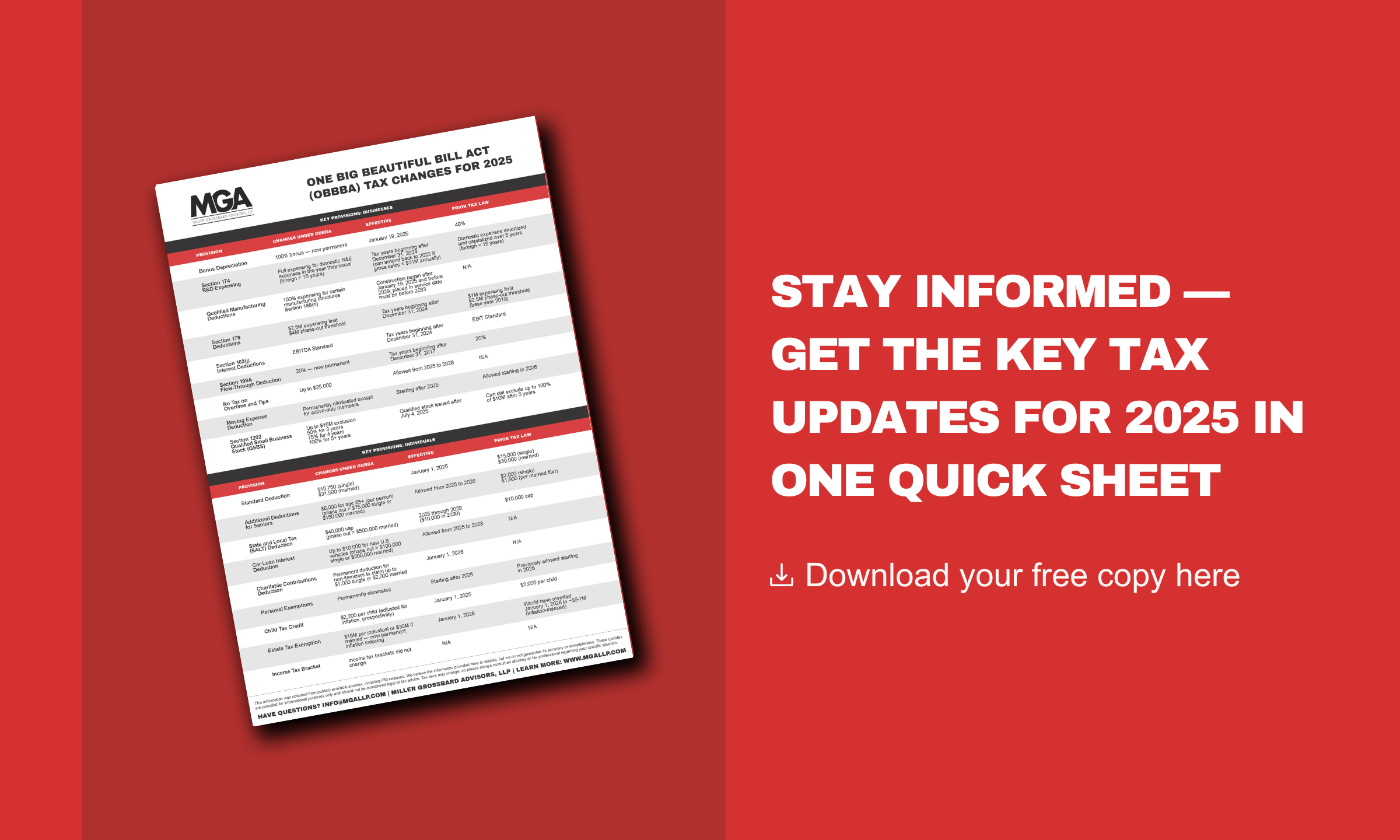The Tax Cuts and Jobs Act created new limits on the deductibility of business interest expense for all businesses. While it generated a level of concern when passed, the depth of how many taxpayers it could affect flew somewhat under the radar.
In the video below, Barry Hollingshead, Tax Manager at MGA, shares some valuable insight on how the new limitation works, exceptions to the new rules that you should be aware of, and how the MGA tax team is evaluating this for each of our clients.
While we attempt to keep the information brief and topical, we recognize that there is a lot that goes into this new limitation. It’s complex and deep, but our tax team understands the intricate details of it, making us a reliable and trusted resource to help you out.
Old Rules vs. New Rules
Under the old rules, before the TCJA, business interest expense was generally deductible for partnerships and S corporations. Some regular corporations could be restricted, but this was uncommon.
Under the new rules, the same limitations apply to all taxpayers, including pass-through entities, corporations, individuals, and trusts.
Many of our clients here at MGA are highly leveraged, and business interest expense is a substantial portion of their annual expense, so any limitation on that deductibility could have a significant impact.
A Breakdown of How This Complex New Limitation Works
The new business interest limitation rules are complex, somewhat ambiguous, and poorly written in certain areas. The IRS has also been slow in giving us additional guidance on how they should be interpreted.
To start, you need to calculate your Adjusted Taxable Income (ATI), which we will cover in greater detail later in this section. Once this has been calculated, you then multiply the ATI by 30%. This is your business interest limitation. Any business interest in excess of that limitation is carried over to a future year and is called Excess Business Interest (EBI). It can only be used in a future year if there’s excess taxable income from that same activity.
It was initially believed that most taxpayers would not get caught by the limitations since there is an exception for “Small Business Taxpayers.” A small business taxpayer is someone whose average gross receipts for the previous three years are $25 million or less. However, the catch is in how this is considered and possible aggregation with commonly controlled entities. For example, your business could be below the $25 million gross receipts threshold, but the gross receipts for your aggregated group could push you over the $25 million.
The second exception that did not garner much attention was the old tax shelter or syndicate rules. The tax shelter and syndicate rules have been around for a long time but can “capture” many businesses and drag them into a possible business interest limitation. To explain the syndicate rules, if more than 35% of your losses (in a specific tax year) are allocated to either limited partners or limited entrepreneurs, you are considered a syndicate. If you are considered a syndicate, you cannot be excepted. This is the typical make up of most pass-through entities! Some other concepts outside this discussion, like active participation, also need to be considered when deciding if an entity is a syndicate.
Only certain types of entities can choose to elect out of the business interest limitation rules — real property or farming trades or businesses. If you elect out, it’s irrevocable. You are also required to depreciate certain categories of assets under ADS lives rather than GDS MACRS lives. The assets that must be converted to ADS are nonresidential real property, residential real property, and Qualified Improvement Property (QIP). An election out will result in a slower benefit of depreciation deductions, but in most situations, it could be more beneficial than the loss of interest deductibility.
Now, let’s go back to ATI and discuss what goes into that calculation. ATI starts with your taxable income or loss, and then you add back and deduct certain items.
- An entity adds back items that are not related to a trade or business, business income and expense, any NOl deduction, deductions for QBID, and depreciation/amortization/depletion.
- ATI is reduced by any income or gain not related to a trade or business, any interest income not from a pass-through entity, and if a property is sold you must add back the lesser of the gain or the depreciation/amortization/depletion.
The ATI, as mentioned above, is then multiplied by 30%, and that is your limitation on business interest expense. Any business interest expense above that threshold (if you do not meet one of the exceptions and cannot elect out) is carried over and can only be offset with Excess Taxable Income (ETI) from that same activity in future years.
To Sum It Up, Here Are the Hurdles You Need to Get Over
- First, do you have business interest expense and could you be subject to a limitation?
- Second, do you meet one of the exceptions? Are your average gross receipts at or below $25 million (do not forget to consider the aggregation rules)? Are you considered a syndicate?
- Lastly, if you do not meet one of the exceptions, are you able to elect out? Does it make sense to elect out if you can?
Keep in mind that there can also be situations where you do not have a limitation, but you are required to complete the forms since you do not meet one of the exceptions.
How the MGA Tax Team Is Evaluating This for Each of Our Clients
At MGA, we have developed a decision tree analysis and template that we walk through for each of our clients. We are also monitoring all additional guidance from the IRS and speaking with each of our clients to make sure that they agree with our recommendations for their businesses.
As we mentioned previously, we understand that this new rule is complex and deep. While it’s challenging to offer a simple explanation of the intricate details, we want to make sure you know that our tax team understands it all, making us a trusted resource for advice and guidance.
If we can help you with tax planning and understanding the new tax law, please don't hesitate to reach out to us.
We are here to make the complex simple.
.png?width=191&name=mgalogofinal-01%20(3).png)





